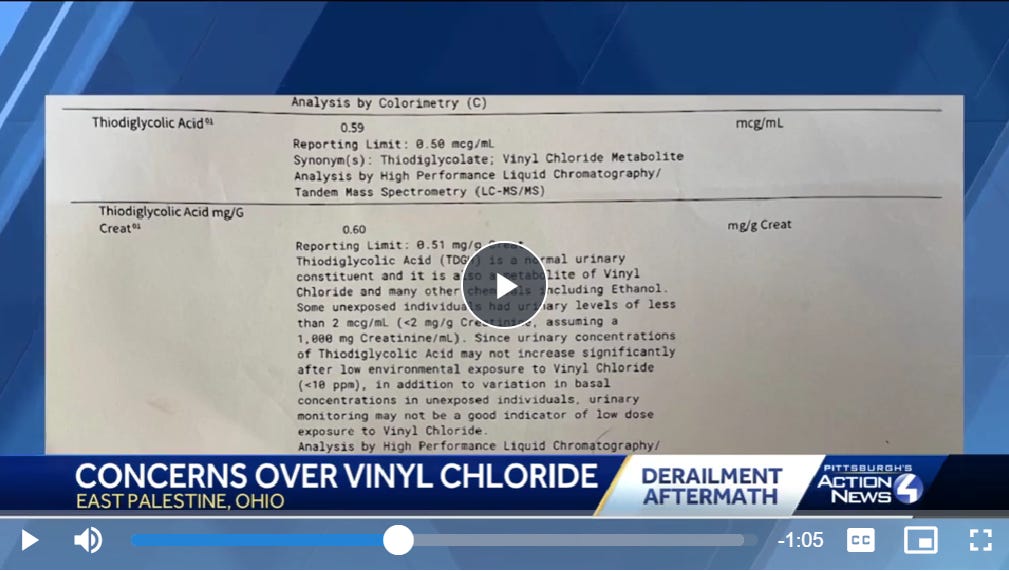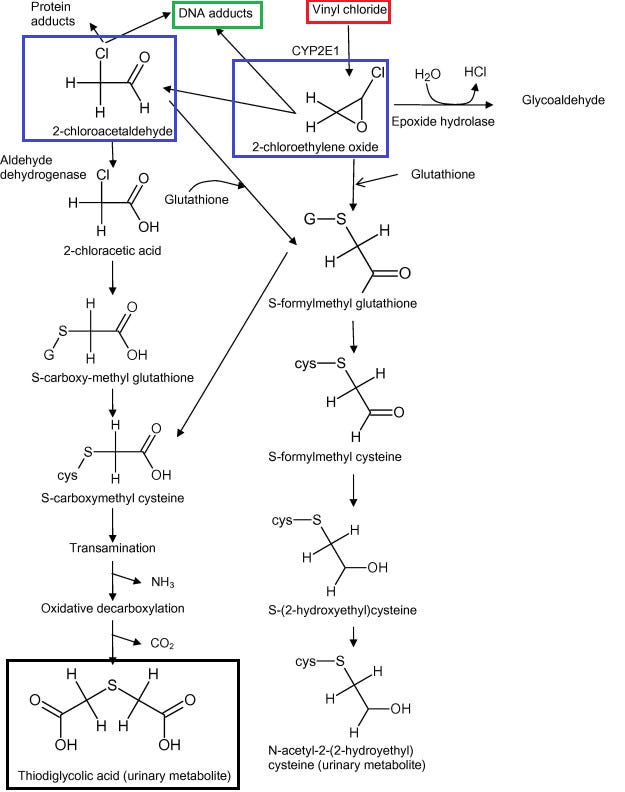EPA releases dioxin results for East Palestine City Park
And results of urinalysis tests from East Palestine residents note elevated levels of benzene and vinyl chloride metabolites.
This is part of an ongoing series reporting information with respect to the East Palestine derailment. Past posts have been collected into an Anthology Series.
EPA releases dioxin soil results
Last week, ahead of Easter, the EPA finally released some preliminary dioxin soil sampling results. This comes as questions still remain in regards to chemical exposure for residents of East Palestine, with clear answers still not being provided.
These dioxin results were apparently released in relation to the warming weather, as the EPA remarks that people would like to know if parks and other outdoor areas would be considered safe.
The results of this testing focused predominately on East Palestine City Park, with many of the playground equipment being cleaned and mulch removed for disposal in case of toxins.
The EPA notes this on their website, suggesting that dioxin levels and levels of other semi-volatile organic compounds were either below or at background levels (emphasis mine):
April 6, 2023 - As springtime activities begin, residents wanted to make sure the park was safe for regular use. Soil samples have been taken across the park in seven spots that represent the overall area and use of the park. Results show that levels of dioxin and semi-volatile organic compounds are well below any levels that we would consider restricting activities, and all are either at or below typical background levels in the United States. Air monitoring at the park also shows that no contaminants are going off site from work areas.
In addition, the village has cleaned recreational equipment, including the pool, tennis courts, and playground to get the park ready for the season. All of the mulch and the landscape fabric were removed. The playground was then power washed and disinfected, followed by the installation of new landscape fabric, 90 tons of new playground mulch, and new sod.
Looking at all of these pieces together, EPA feels confident that residents can safely use the park.
The results of the soil testing can be found in the link above.
In contrast to the prior soil results the results from City Park appear to be in the single digits in total Dioxin-furan levels:

Translating the above results into ppt would require multiplying the results by 1 million, or moving the decimal place over to the right 6 digits.
Although the above results don’t provide a toxic equivalency value (TEQ), we can argue that if the dioxin-furan collected were purely 2,3,7,8-TCDD the TEQ value would still fall within the single digits (the actual values for 2,3,7,8-TCDD in each sample appear to fall below the detection level, which does not mean that 2,3,7,8-TCDD is not present but are at levels low enough not to be adequately quantified).
These values are in stark contrast to two samples taken from soil removed from the train derailment site, which noted around a 110 ppt and 150 ppt TEQ value, respectively (note I am not using the 700 ppt value because there are some questions about the validity of this result, especially given that the same sample gave a TEQ value of 150 ppt).
Now, the question remains whether these values are actually safe. Consider that soil levels may not serve as accurate predictors of dioxin exposure, with anecdotes from prior incidences of dioxin exposure suggesting a stronger relationship between aerial exposure rather than soil exposure with respect to dioxin serum levels.
In that case, it could be argued that the area may be deemed “safe”, but that deeming this area safe doesn’t say much of the actual exposure risk of East Palestine residents during the actual fire.
Given that TEQ levels of the removed soil were far higher relative to the City Park soil, we may argue that exposure to dioxin may decrease with increased distance from the fire, and it’s possible that much of the dioxin produced may have settled within the vicinity of the derailment (not taking wind and other environmental variables into play).
However, as previously stated, the real values lie on whether toxicology reports will provide any measure of dioxin exposure via serum testing. This will be one of the only ways of getting accurate information with respect to dioxin exposure, and as of yet it doesn’t appear that such testing has occurred.
Vinyl Chloride and Benzene metabolites found in urine of East Palestine residents
Even as full toxicology results have yet to be released, limited reports have noted trace levels of various organic compounds.
A few days ago one resident, Linda Murphy, along with her husband Russell, reported results of a urinalysis which noted elevated levels of one vinyl chloride metabolite named Thiodiglycolic Acid.
A video from ABC4 WTAE shows some of the results of this urinalysis:

If readers recall from a prior post thiodiglycolic acid is the end, non-reactive metabolite of liver vinyl chloride metabolism (boxed in black below)1:

Because thiodiglycolic acid is the end metabolite it’s possible that vinyl chloride may have been metabolized into the electrophilic intermediate compounds 2-chloroacetaldehyde and 2-chloroethylene oxide (boxed in blue), and it’s these compounds in particular that are argued to be carcinogens due to their abilities to act as both protein and DNA adducts (boxed in green).
DNA adducts refer to a complex formed by a portion of DNA that binds to another compound. The new complex tends to interfere with proper hydrogen bonding between strands of DNA, and thus the formation of these adducts may lead to improper base insertions during replication which may cause mutations to arise if not corrected for.
Linda Murphy describes her symptoms as the following, taken from the transcript of the WTAE video:
I JUST FELT LIKE MY EYES WERE TIRED AND SWOLLEN. EXTREME SORE THROAT. ALMOST LIKE I HAD DRANK HOT LIQUIDS. MY VOICE WAS GOING IN AND OUT. I HAD A LOT OF TROUBLE BREATHING, DIFFICULTY TAKING IN A DEEP BREATH, ESPECIALLY IN THE EVENINGS.
Remember that the train report from the EPA suggests that none of the tanks carrying vinyl chloride were ruptured due to the derailment. It’s possible that thiodiglycolic acid may be a metabolite of other compounds, but it’s also likely that not all vinyl chloride combusted in the controlled fire. Due to its high volatility, it’s possible that some of that vinyl chloride escaped intact into the air.
It’s also worth remembering that lack of baseline information means that there’s no frame of reference for these residents, as it’s also possible that exposure to vinyl chloride for East Palestine residents may be higher relative to the general population given that it’s an industrial town.
Again, lack of data means that it’s hard to compare this information.
In another account Shelby Walker, who lives 900 feet from the derailment, also appeared to have elevated levels of vinyl chloride and benzene based on a urinalysis.
Walker appears to be one of the first people to have received testing. Unfortunately, not much else has been provided with respect to her urinalysis results. In one interview on WKBN Walker notes that her voice will now occasionally become raspy, and she now must use an inhaler.
Two of the tanks in the train derailment appear to have contained benzene, although the EPA report suggests that the tanks were not breached because of the derailment:
This may add further corroboration to the fact that some of the compounds from these tanks may have been released into the local environment during the controlled burning, and thus may have put locals at risk. There’s also the possibility that the tanks were improperly recorded, and may have in fact ruptured, but that would be speculation as of now.
As reported previously, the presence of elevated acrolein levels may suggest that acrylates were burned in the derailment prior to the controlled fire, and residents may have been exposed to some of these combusted products before the evacuation. Evidence suggests that some of the acrylate tanks were in various states of empty, with the tank carrying butyl acrylates appearing completely empty due to a spill and fire.
This, again, highlights the issue with corroborating symptoms with the timeline of events.
Murphy doesn’t appear to live as close to derailment site as Walker as she has commented that she lives about 2.8 miles away, and thus may not have been exposed to the same degree as Walker.
However, it’s also important to keep in mind that urine levels of thiodiglycolic acid would follow an elimination curve and would depend on enzyme saturation and possibly glutathione levels, including any possible mutations in enzymes responsible for the metabolism of vinyl chloride.
This would mean that Murphy’s levels are likely to have been far higher during the acute exposure phase, with her current levels depending upon both metabolism, as well as other environmental exposures.
An overview of absorption, distribution, metabolism, and excretion studies for vinyl chloride can be found on PubChem.
All of this points to how critical timing is when collecting samples. It’s likely that any data collected now, aside from dioxin due to its long half-life, may be heavily compounded by background levels and other routes of exposure.
More data is always better, but I’m curious if current results will provide anything meaningful as residents move away from acute concerns towards long-term health concerns.
Substack is my main source of income and all support helps to support me in my daily life. If you enjoyed this post and other works please consider supporting me through a paid Substack subscription or through my Ko-fi. Any bit helps, and it encourages independent creators and journalists such as myself to provide work outside of the mainstream narrative.

Sherman M. (2009). Vinyl chloride and the liver. Journal of hepatology, 51(6), 1074–1081. https://doi.org/10.1016/j.jhep.2009.09.012






Well done. Concise and precise as well as open ended possibles. Couple this chemical exposure with compromised immune systems.
No sweat. I have a thicker skin than that